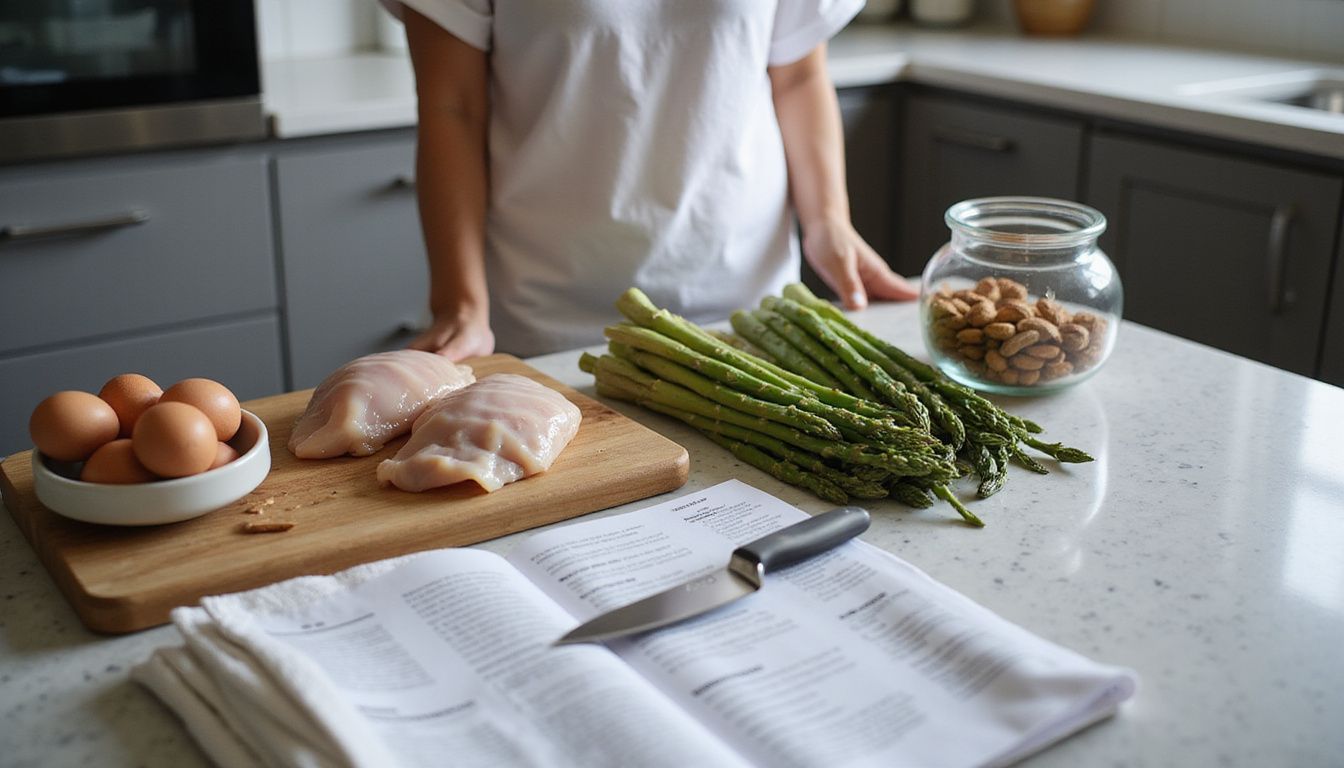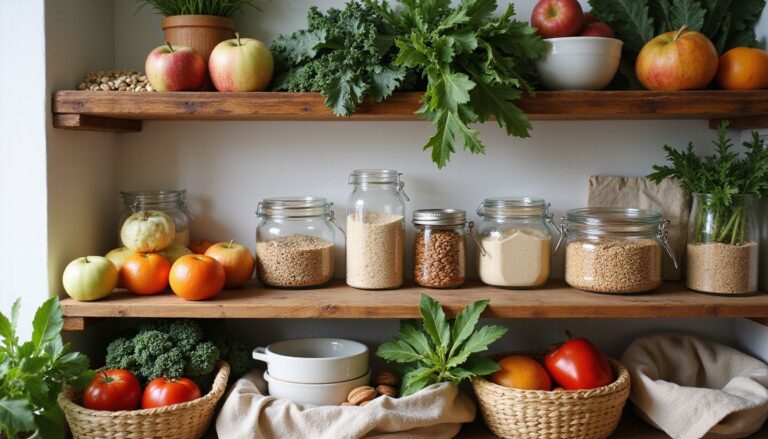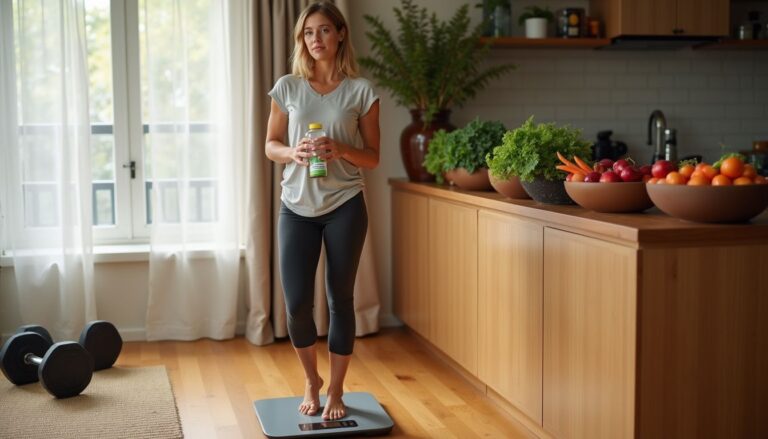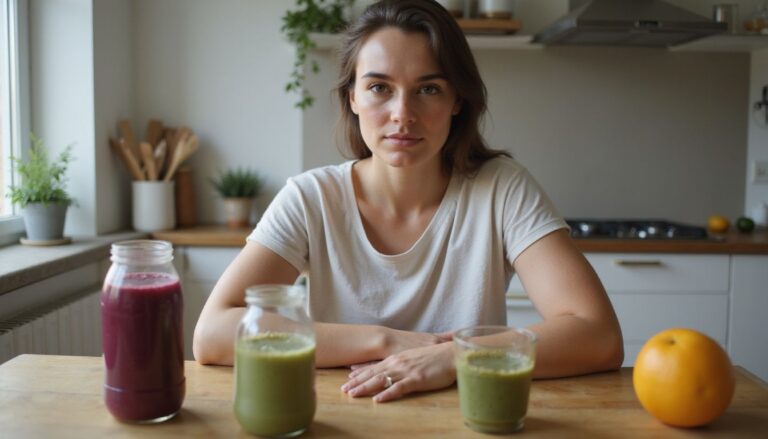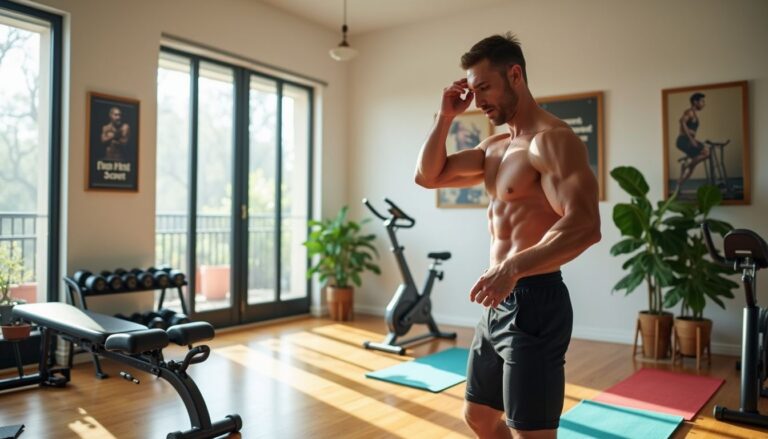7-Day High-Protein Meal Plan For Weight Loss
Our Nutrition Assistant AI Suite will transform your body. You will lose fat, get toned, and build muscle. Gain confidence and optimal health.
Finding steady weight loss can feel hard. A simple shift to a high-protein meal plan can help you feel full, manage cravings, and protect muscle while you cut calories.
This 7-day plan, created with guidance from registered dietitian nutritionist Devine Lingo, focuses on balanced meals with at least 80 grams of protein and 30 grams of fiber each day. The goal is practical weight loss without extreme rules.
You get clear daily menus, prep tips, and plain-language science on how protein helps. Use the plan as a guide, then adjust portions to fit your needs and activity level.
Key Takeaways
- The 7-day plan provides at least 80 grams of protein and 30 grams of fiber per day to support weight loss and steady energy.
- Protein boosts fullness, lowers hunger hormones like ghrelin, and raises calorie burn through thermogenesis, the energy cost of digesting food.
- Each day includes lean proteins, whole grains, fruits, vegetables, and healthy fats while keeping sodium near 1,800 milligrams or lower.
- Daily calories sit around 1,500 with options for 1,800 to 2,000. Light strength training twice weekly helps maintain muscle.
- More than 9 in 10 U.S. adults do not get enough fiber. Pairing protein with fiber improves fullness in a safe, sustainable way.
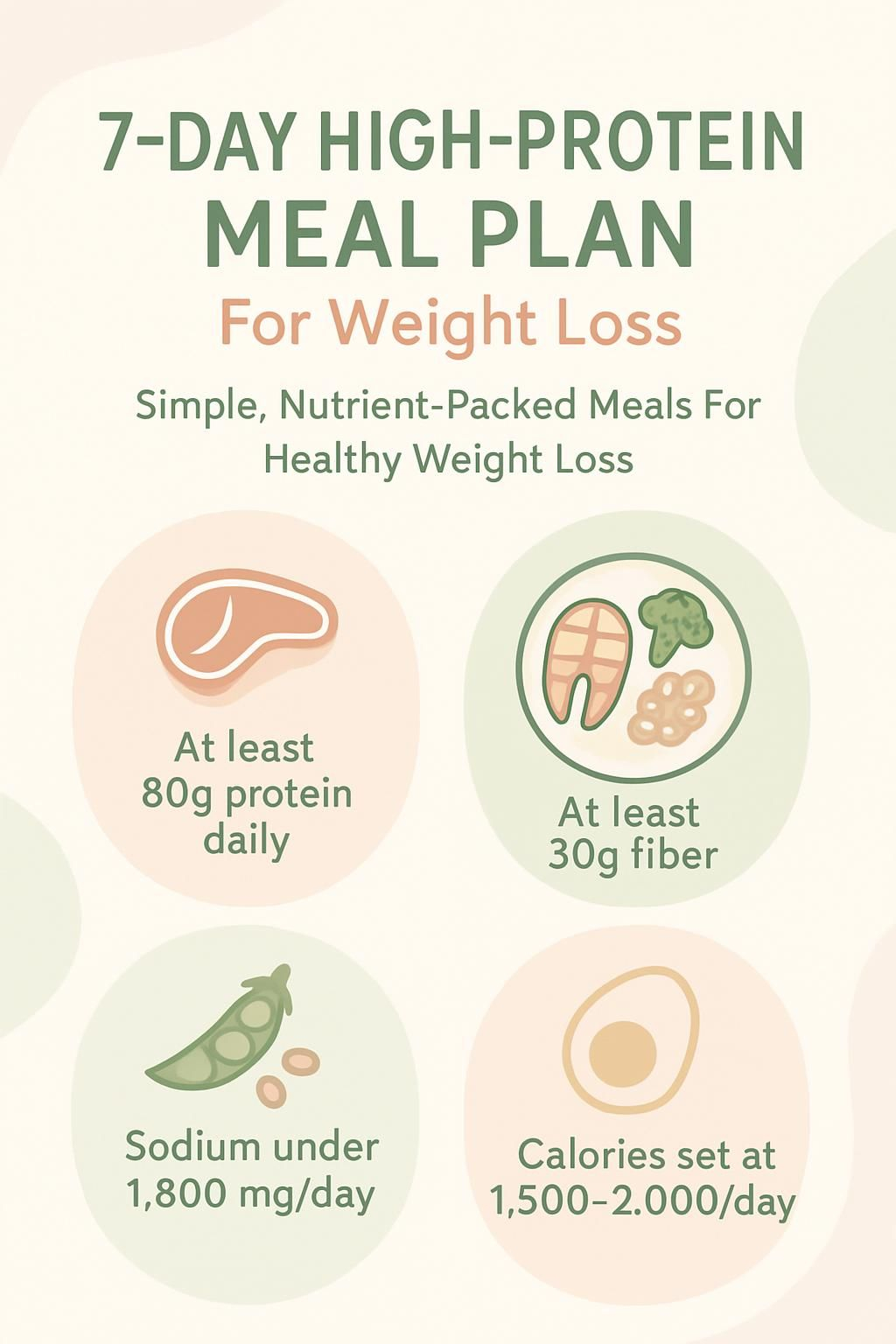
How Does Protein Help with Weight Loss?
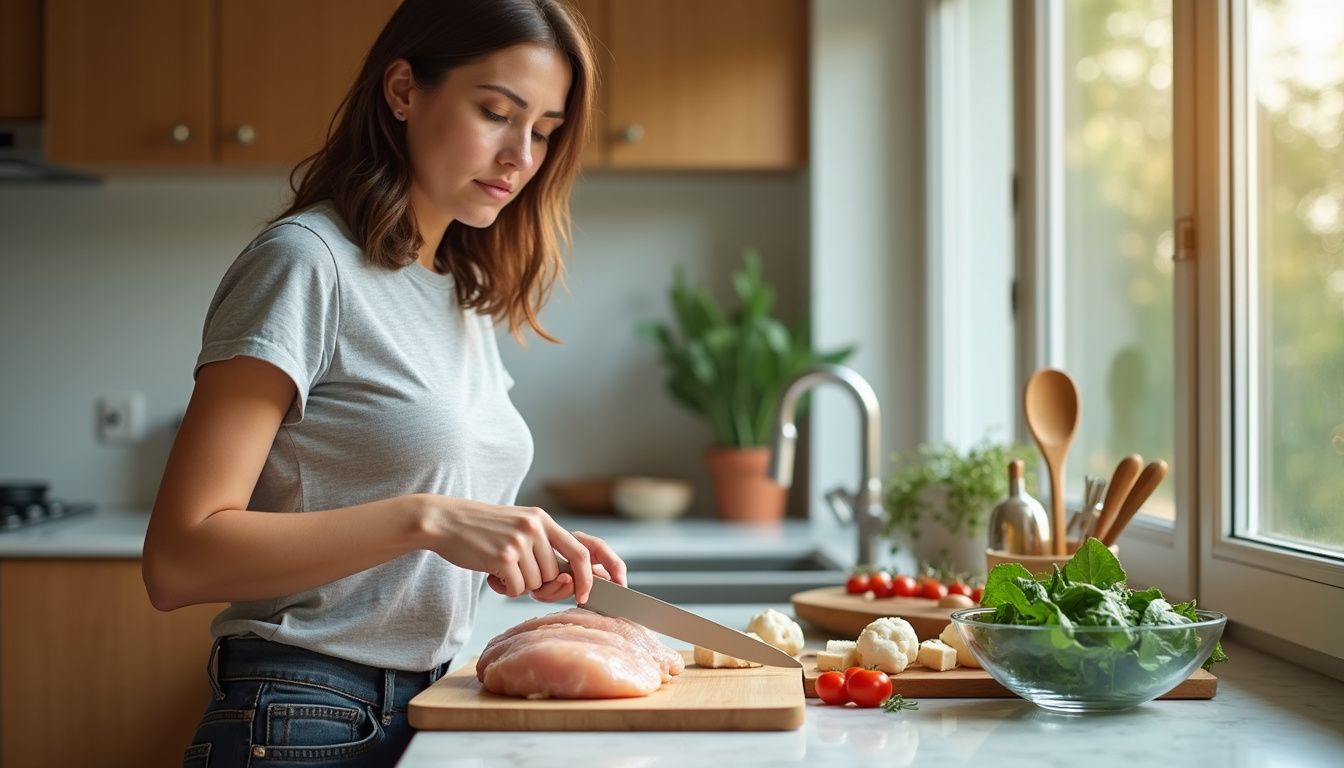
Protein helps you lose weight because it increases satiety, which means the feeling of fullness, and reduces hunger. High-protein meals raise satiety hormones and lower ghrelin, the hormone that signals hunger.
This plan gives you at least 80 grams of protein daily, which supports appetite control and helps you stick to your calorie targets. Fewer cravings make the process easier and more consistent.
Pairing protein with fiber, especially soluble fiber from fruits and vegetables, brings extra benefits. Soluble fiber ferments in the large intestine and forms short-chain fatty acids. These help with appetite regulation and can lower inflammation.
Current surveys show that most adults in the United States fall short on fiber. Building meals with both protein and fiber helps you manage weight without very low-calorie diets that leave you drained.
I noticed fewer cravings after switching to higher-protein breakfasts like eggs with avocado, which kept me satisfied until lunchtime.
Next, see the key reasons a higher-protein approach supports fat loss and muscle health.
Key Benefits of Eating a High-Protein Diet
High-protein foods make it easier to meet your protein needs inside a healthy diet. Research links higher protein to better weight management, improved body composition, and steady energy.
How Does Protein Boost Metabolism?
Your body spends more calories digesting protein than it does digesting carbs or fats. This is called diet-induced thermogenesis. It simply means protein costs more energy to process.
After a protein-rich meal, such as grilled chicken or cottage cheese, you may feel a mild warmth. That is your metabolism working. Over time, these small boosts add up.
This plan provides at least 80 grams of protein daily, and Day 6 reaches 113 grams. That level supports a slightly higher daily calorie burn compared with lower-protein diets.
Protein-rich foods like Greek yogurt, eggs, and salmon also support metabolic health. Add soluble fiber from beans, chickpeas, and whole grains to support gut health and help keep metabolism active.
Can Protein Reduce Cravings?
Yes. Protein dampens ghrelin, the hunger hormone, and keeps you full between meals. Options like Greek yogurt, cottage cheese, and hard-boiled eggs are simple and effective.
Every day in this 7-day plan supplies at least 80 grams of protein and at least 30 grams of fiber. That combination supports portion control and fewer snack attacks.
High-protein snacks make a difference. Try nuts, hummus with carrots, or a protein bar for late-day hunger. After I swapped chips for a boiled egg in the afternoon, my sugar cravings dropped in a week.
After swapping my usual afternoon cookie for a protein smoothie with banana and almond milk on Day 2, my need to snack all evening went away.
Why Is Protein Important for Muscle Maintenance?
During a calorie deficit, your body may break down muscle to meet energy needs. Enough protein helps prevent that loss. It supports repair and recovery after daily activity or training.
Lean muscle burns more calories at rest, so keeping it helps your metabolism. Meals in this plan deliver 80 to 113 grams daily to protect muscle as you lose fat.
Most dietitians suggest strength training at least twice per week. Protein and resistance exercise work together to preserve muscle.
Easy picks include chicken salad, eggs, tofu, fish, and strained yogurt. When I raised my protein from these foods, I had better energy for lifting and felt stronger while losing fat.
Studies indicate higher-protein diets support muscle while improving weight and metabolic markers.
How Does Protein Increase Fullness?
Protein raises fullness hormones like peptide YY and GLP-1 and lowers ghrelin. That signals your brain that you are satisfied.
Slow-digesting options such as Greek yogurt, eggs, and chicken keep you full for longer. With at least 80 grams of protein per day, the plan supports hunger control between meals.
Soluble fiber from oats and beans works with protein to extend fullness. Hitting 30 grams of fiber per day amplifies the effect.
Structured meals and snacks reduce long gaps that drive overeating. Pairing protein with fibrous sides like apple slices or chickpeas has kept me satisfied well into the afternoon.
Next, you may ask how much protein is right for effective weight loss.
How Much Protein Should You Eat to Lose Weight?
Most adults do well with at least 80 grams of protein per day when trying to lose weight. The Dietary Guidelines for Americans suggest building meals around protein-rich foods to support fullness and muscle.
People who weigh more or train often may need more protein per kilogram of body weight. Needs rise with activity and age.
This plan targets 1,500 calories per day with no less than 80 grams of protein. You can reach 1,800 or 2,000 calories by adding protein-focused snacks like Greek yogurt, nuts, or cottage cheese.
The plan avoids very low-calorie, 1,200-calorie menus. Those can miss nutrients and are hard to sustain, according to nutrition analyses such as ESHA Food Processor.
How to Build a High-Protein Meal Plan
Build your week with a mix of protein, healthy fats, and smart carbs. Choose foods like eggs, chicken, tofu, and low-fat dairy. Pick low glycemic index, or low GI, options to support steady blood sugar.
Which Protein Sources Should You Choose?
Focus on lean choices like grilled chicken, eggs, and tofu. Include fish rich in omega-3 fats, such as salmon, cod, and shrimp, to support heart health.
Add plant protein from lentils, chickpeas, edamame, and black beans for both protein and fiber. Beans have a low GI, which helps stabilize blood sugar.
For snacks, try low-fat Greek yogurt or cottage cheese. Nuts and seeds, like almonds or mixed nuts, can also help you reach your protein goals.
Use Greek yogurt in smoothies or parfaits. One cup of nonfat Greek yogurt has around 15 to 20 grams of protein. Day 5 features lettuce-wrapped turkey burgers, and hummus with carrot sticks is an easy, filling option.
Batch-cooking grilled chicken has saved me on busy nights. It kept me satisfied and cut my intake of processed foods.
Prioritize whole foods over processed meats for better long-term health.
How to Combine Protein with Healthy Fats and Carbs
Pair protein with complex carbs and healthy fats at each meal. This balance steadies energy and helps you feel full.
- Grilled chicken or fish with quinoa or sweet potato plus a drizzle of olive oil
- Grilled chicken salad with cherry tomatoes and avocado
- Greek yogurt parfait with berries and a sprinkle of nuts
- Beans or lentils mixed with brown rice or couscous and vegetables
Lean fish, such as salmon or baked cod, supplies quality protein and omega-3 fats. Keep added sugars low to avoid blood sugar spikes and energy crashes.
Build a colorful plate with protein, healthy fat, and complex carbs. This approach supports digestion, satiety, and weight control.
What Is the Best Way to Organize Meals and Snacks?
A predictable structure helps you avoid grazing. Plan four eating times each day. Aim for breakfast, a snack, lunch, and dinner.
This rhythm reduces big hunger swings. A Greek yogurt parfait in the morning, hard-boiled eggs and crunchy veggies as a snack, a grilled chicken salad for lunch, and baked salmon at dinner is one example.
Prep ahead when you can. Make overnight oats or Chickpea Tuna Salad the night before. Rotate snacks like nuts, Greek yogurt, or string cheese to reach at least 80 grams of protein and 30 grams of fiber daily.
Increase to 1,800 or 2,000 calories with an extra snack if your activity level is higher. Mixing and matching recipes works as long as you keep the balance of nutrients.
This approach adapts to different eating styles, including vegetarian options, and supports steady progress.
Why Is Staying Hydrated Important?
Hydration supports digestion and helps you feel full at meals. Water also helps your body use protein and fiber from foods like Greek yogurt, lentils, and spinach.
Water-rich foods such as fruits and vegetables count toward fluids. A glass of water before meals may reduce appetite in some people.
Daily movement feels better when you are hydrated, which helps you stick to exercise. I snack less when I carry a water bottle on busy days. Most people do well with 8 to 10 cups a day, though needs vary with activity and heat.
Staying hydrated is a simple habit that supports your high-protein plan.
Seven-Day High-Protein Meal Plan
Use this seven-day template to hit your protein targets and support weight loss. Meals feature lean protein, vegetables, whole grains, and healthy fats.
Day 1
Start with a Raspberry-Peach Chia Seed Smoothie for breakfast at 352 calories. For a morning snack, have hummus with carrots, red bell pepper, and edamame for 299 calories. You get fiber and plant protein in minutes.
Lunch is a Chickpea, Beet & Feta Salad at 398 calories. It is a plant-forward option that supports muscle maintenance.
Dinner is roasted salmon with broccoli rice bowls at 443 calories. You get lean protein and heart-friendly omega-3 fats. Daily totals: 1,491 calories, 67 grams fat, 86 grams protein, 154 grams carbs, 48 grams fiber, and 1,601 milligrams sodium.
To reach 1,800 calories, add Greek yogurt with raspberries and chia seeds as an afternoon snack. For 2,000 calories, enjoy Anti-Inflammatory Energy Balls as a dessert.
This lineup uses familiar foods like wheat, greens, onion, and slaw-style vegetables to keep meals satisfying.
Morning Meal: Greek Yogurt Parfait with Granola and Berries
Layer plain Greek yogurt with granola and berries for a quick, high-protein start. One cup of yogurt can provide up to 20 grams of protein, which supports muscle and satiety.
Raspberries and blueberries add fiber and antioxidants. A tablespoon of chia seeds and some sliced almonds add healthy fats and crunch without added sugar.
Pick a lower-sugar granola to increase fiber and reduce empty calories. This breakfast helps reduce cravings later, which may lower your risk of overeating.
In my graduate nutrition program, we saw that dairy protein with nuts beats carbs alone for fullness. You also get calcium, vitamin C from berries, and steady energy.
Next up, a simple noon meal.
Noon Meal: Grilled Chicken Salad with Cherry Tomatoes and Avocado
After a protein-rich breakfast, move to a grilled chicken salad for lunch. It delivers about 35 grams of protein per serving and keeps you full into the afternoon.
Top crisp lettuce with grilled chicken, cherry tomatoes, and sliced avocado. Tomatoes bring color and vitamin C, while avocado provides healthy fats that improve nutrient absorption.
Dress with olive oil, vinegar, garlic, salt, and pepper for clean flavor. Pairing lean protein with fiber-rich vegetables is linked to better weight outcomes and fewer cravings later.
Evening Meal: Baked Salmon with Quinoa and Steamed Broccoli
Baked salmon offers omega-3 fats for heart health and supports fat loss. A serving similar to the Roasted Salmon & Broccoli Rice Bowl is around 443 calories, which makes tracking easier.
Quinoa adds complete plant protein. Steamed broccoli supplies fiber and vitamins from cruciferous vegetables.
Brighten flavors with a squeeze of orange juice or a light soy sauce drizzle. When I made this combo last year, late-night cravings faded because dinner kept me full.
Steaming broccoli preserves nutrients, and this protein-carb-fiber trio delivers a satisfying, balanced plate.
Snack: Hard-Boiled Eggs and Cucumber Slices
End the day with a light, filling snack. One hard-boiled egg provides about 6 grams of protein and essential amino acids for recovery.
Pair it with hydrating cucumber slices to add volume with very few calories. This mini meal works well for athletes and busy parents because it travels easily and requires minimal prep.
Day 2
Begin with a protein smoothie made with almond milk, banana, and protein powder. It delivers steady energy and keeps you satisfied. Lunch is a turkey and avocado wrap with fresh veggies for protein and fiber without excess calories.
For dinner, grill steak and add roasted sweet potatoes and asparagus. Cottage cheese with pineapple chunks is an easy, high-protein snack. Your totals are about 1,499 calories, 63 grams fat, 88 grams protein, 149 grams carbs, 31 grams fiber, and 1,701 milligrams sodium.
Need more calories? Add hummus with carrots or bell pepper in the afternoon. Lemon-blueberry frozen yogurt bites can top off your evening if you are aiming higher.
I once made overnight oats with Greek flavors, and it kept me full after a morning run. Simple swaps like choosing cottage cheese over some spreads helped me hold sodium near 1,700 milligrams without losing flavor.
Here are the Day 2 nutrition stats:
- Total Calories: 1,499
- Fat: 63g
- Protein: 88g
- Carbohydrates: 149g
- Fiber: 31g
- Sodium: 1,701mg
Morning Meal: Protein Smoothie with Almond Milk, Banana, and Protein Powder
Blend almond milk, banana, and protein powder for a quick morning shake. It is a strong start to Day 2 and helps with fullness.
Almond milk keeps calories light, and banana adds fiber and natural sweetness. Many high-protein breakfasts, like the Day 1 smoothie with 352 calories, deliver protein and fiber for steady energy.
High-protein breakfasts can reduce snacking later in the day. With a blender and a few ingredients, you can prep this in minutes.
Then move to your high-protein lunch wrap.
Noon Meal: Turkey and Avocado Wrap with Fresh Veggies
Fill a whole-grain tortilla with lean turkey and ripe avocado. Add celery sticks, sliced tomato, and crisp lettuce for crunch and vitamins.
This wrap provides about 25 grams of protein, helping you stay full until your next snack. Turkey is low in fat and rich in B vitamins that support energy.
Prep a few wraps ahead if your week is busy. Roasted bell peppers or sprouts add flavor and nutrients. Switching from typical sandwiches to this wrap helped me cut calories and feel satisfied longer.
Quick stats:
- Calories: 350–400
- Protein: 25g
- Carbs: 30g
- Fiber: 8g
Evening Meal: Grilled Steak with Roasted Sweet Potatoes and Asparagus
Grilled steak supplies lean protein for muscle support and satiety. Roasted sweet potatoes and asparagus add fiber and key vitamins for a balanced plate.
Cooking everything on one tray saves time and cleanup. Simple spices bring out strong flavors without extra calories.
Aim for about 502 calories per serving, similar to sheet-pan chicken thigh dinners with red cabbage and sweet potatoes. Then finish with a simple snack.
Snack: Cottage Cheese with Pineapple Chunks
Pair cottage cheese with pineapple chunks for a balanced, high-protein snack. A serving runs about 281 calories and supports weight loss goals.
Cottage cheese provides slow-digesting casein protein for steady fullness. Pineapple adds vitamin C and a touch of sweetness without added sugar.
This combo boosts calcium and fiber when paired with fruit. Preparing it in a jar makes it easy to grab and go.
Day 3
Start with scrambled eggs, spinach, and whole-grain toast for a protein-rich breakfast. Lunch is a lentil and chickpea salad with feta for plant protein and fiber.
Dinner is a grilled shrimp stir-fry with brown rice. Shrimp is lean and quick to cook. Snack on almonds and a boiled egg to increase protein and healthy fats.
Day 3 totals: 1,490 calories, 70 grams fat, 93 grams protein, 126 grams carbs, 30 grams fiber, and 1,241 milligrams sodium. For the 1,800-calorie option, add hummus, carrots, bell pepper, and edamame as an afternoon snack.
Head into Day 4 with more simple, protein-forward ideas.
Morning Meal: Scrambled Eggs with Spinach and Whole-Grain Toast
Scramble eggs with spinach for a fast, high-protein breakfast. Each egg has around 6 grams of protein plus vitamins B12 and D.
Spinach adds fiber, iron, and vitamin K. Whole-grain toast supplies slow carbs and extra fiber to keep you satisfied.
Studies suggest egg breakfasts can reduce hunger and support weight control. Many athletes choose eggs with greens to help maintain muscle during a cut.
Season with black pepper or fresh herbs for an easy upgrade.
Noon Meal: Lentil and Chickpea Salad with Feta Cheese
Pack a lentil and chickpea salad with feta for lunch. A cup of lentils or chickpeas supplies more than 15 grams of plant-based protein and plenty of fiber for fullness.
Feta adds tang and bumps the protein while keeping calories moderate. Meals built with legumes are linked to better satiety and blood sugar control.
Prepare this salad in advance for fast lunches all week. It mirrors the structure of Chickpea Tuna Salad and works well for vegetarians who want more protein without poultry or beef.
Sprouted lentils add freshness and extra nutrients.
Evening Meal: Grilled Shrimp Stir-Fry with Brown Rice
Shift to seafood for dinner with a grilled shrimp stir-fry over brown rice. This dish is light, colorful, and filling.
Cook shrimp with bell peppers, snap peas, and carrots. Serve over one cup of steamed brown rice for fiber and long-lasting energy.
Meals like Shrimp & Pepper Kebabs with Grilled Red Onion Slaw come in around 442 calories and fit well in this plan. Freshly grilled shrimp brings out the natural sweetness of the vegetables.
Explore more seafood ideas in related articles or check FAQs for quick stir-fry tips.
Snack: Almonds and a Boiled Egg
Almonds with a boiled egg deliver about 12 grams of protein and healthy fats. This duo helps limit late-day hunger and supports recovery after activity.
They travel well and need no special prep. I often grab this combo during mid-afternoon slumps. It keeps me satisfied without a sugar crash.
Protein-rich snacks may also slightly increase calorie burn, according to research in the American Journal of Clinical Nutrition.
Day 4
Day 4 keeps your intake steady. Start with high-protein lemon poppyseed overnight oats at 359 calories. Then enjoy a morning snack of one cup low-fat plain Greek yogurt with half a cup raspberries and two tablespoons chia seeds for more fiber.
Lunch is chickpea tuna salad at 357 calories for lean protein. Dinner is a high-protein anti-inflammatory vegetable soup at 478 calories to support recovery if you train.
Daily totals are about 1,494 calories with roughly 80 grams protein, 32 grams fiber, and just over 1,200 milligrams sodium. If you are more active, add hummus with carrots or edamame in the afternoon for extra energy.
Morning Meal: Protein Pancakes with Greek Yogurt and Strawberries
Protein pancakes provide more protein than typical pancakes and keep you full longer. Top with a half-cup Greek yogurt for creaminess and about 10 more grams of protein.
Add a half-cup sliced strawberries for natural sweetness, fiber, and vitamin C. Higher-protein breakfasts can reduce lunchtime calories by about 18 percent¹.
Greek yogurt and berries support muscle and supply antioxidants with great taste.
Noon Meal: Tuna Salad with Mixed Greens and Olive Oil Dressing
After a filling breakfast, enjoy tuna salad over mixed greens for lunch. Each serving is about 357 calories, which fits easily into weight loss plans.
Tuna offers lean protein that helps you stay full. Olive oil provides healthy fats and improves absorption of fat-soluble vitamins. I rely on this meal during busy weeks because it keeps my energy stable until dinner.
Greens add fiber, vitamins, and minerals for a balanced, high-protein mid-day meal.
Evening Meal: Roasted Chicken Thighs with Mashed Cauliflower and Green Beans
Round out the day with roasted chicken thighs for about 502 calories. They deliver high-quality protein for muscle repair during weight loss.
Mashed cauliflower is a lower-carb swap for mashed potatoes that still adds fiber. Green beans bring vitamins A and C along with extra fiber.
Sheet-pan methods save time since everything cooks together. This dinner keeps carbs moderate and protein high, which helps reduce late-night cravings according to guidance from Harvard Health Publishing¹.
…
¹Harvard T.H. Chan School of Public Health, “The Nutrition Source: Protein.”.
Snack: Protein Bar
After dinner, a protein bar makes a quick, portable snack. Look for 15 to 20 grams of protein with 6 grams or less of sugar.
Common protein sources include whey, soy, or pea protein. Choose bars with whole foods like nuts or oats listed early in the ingredient list.
Keeping one in your bag ensures a filling option that supports your plan when life gets busy.
Day 5
Have lemon poppyseed overnight oats for breakfast at 359 calories. For a morning snack, eat one cup of low-fat plain Greek yogurt with one cup raspberries and three tablespoons chia seeds for about 383 calories and a fiber bump.
Lunch is chickpea tuna salad at 357 calories. Dinner is sheet-pan mojo chicken with green beans and potatoes at 413 calories.
Day 5 totals 1,512 calories, with 65 grams fat, 98 grams protein, 139 grams carbs, 35 grams fiber, and 1,289 milligrams sodium. For 1,800 calories, add hummus with carrots, red bell pepper, and edamame in the afternoon.
To reach about 2,000 calories, include Anti-Inflammatory Energy Balls as an evening snack. You stay flexible while keeping protein high.
Morning Meal: Omelette with Mushrooms, Tomatoes, and Cheese
Make an omelette with mushrooms, tomatoes, and cheese for a high-protein breakfast. Eggs and cheese provide protein that supports fullness and muscle.
Mushrooms and tomatoes add vitamins and fiber. With avocado and kale, a serving is about 339 calories. Many nutrition experts favor eggs in the morning to support satiety during weight loss.
It takes under fifteen minutes and gets easier with pre-chopped vegetables. Eating protein early also helps curb cravings later, as noted by Harvard T.H. Chan School of Public Health.
Noon Meal: Grilled Turkey Burger with Lettuce Wrap and Sweet Potato Fries
Swap the bun for crisp lettuce and enjoy a grilled turkey burger. You get lean protein for fullness while keeping calories in check.
Serve with oven-baked sweet potato fries for complex carbs, vitamin A, and fiber. Meals like Sheet-Pan Mojo Chicken at 413 calories show how lean meats and vegetables fit a high-protein plan.
Smart swaps keep flavor high and nutrition on point.
Evening Meal: Tofu Stir-Fry with Zucchini Noodles
Continue your plan with a tofu stir-fry over zucchini noodles. A half-cup of tofu has about 10 grams of protein. Zucchini noodles add fiber and keep carbs lower.
Pan-fry firm tofu in olive oil until golden, then toss with bell peppers, snap peas, and carrots. Flavor with low-sodium soy sauce or tamari to limit salt.
Plant-focused dinners like this help control daily calories while maintaining energy through the evening. Prepping extra vegetables in advance helped me stay on track after long workdays.
…
[1] Marry Me White Bean & Spinach Skillet represents another nutritious plant-focused dinner option included in this plan.
Snack: Hummus with Carrot Sticks
Hummus with carrot sticks brings protein and fiber for steady energy. One serving is about 299 calories and supports fullness between meals.
Chickpeas supply plant protein, while carrots and peppers add crunch and vitamins. Edamame is an easy add-on for extra protein.
Portion hummus and cut vegetables ahead to make this snack simple and consistent. It has helped me avoid late-afternoon vending machine trips.
Day 6
Begin with an avocado and kale omelet at 339 calories. For a snack, have hummus with carrots and red bell pepper plus one cup edamame for about 299 calories and a protein lift.
Lunch is chicken and spinach salad with creamy feta dressing at 414 calories. Dinner is lemon-garlic baked cod with roasted vegetables at 468 calories.
The day totals about 1,520 calories, with 81 grams fat, 113 grams protein, 95 grams carbs, 30 grams fiber, and 2,116 milligrams sodium. For 1,800 calories, add a Greek yogurt bowl in the afternoon. For 2,000 calories, try lemon-blueberry frozen yogurt bites at night.
Before Day 7, note how each dish pairs protein with fiber and color to keep meals satisfying.
Morning Meal: Chia Pudding with Almond Butter and Banana Slices
Chia pudding is an easy make-ahead breakfast. Two tablespoons of chia seeds provide about 5 grams of protein and 10 grams of fiber, which supports fullness.
Almond butter adds healthy fats and 3 to 4 grams of extra protein per tablespoon. Banana slices offer potassium to support muscles after sleep.
Stir chia seeds into unsweetened almond milk and chill overnight. In the morning, add almond butter and banana. I rely on this when mornings are tight because it keeps my energy steady until noon.
Noon Meal: Grilled Chicken Wrap with Spinach and Hummus
Grilled chicken brings lean protein. Fresh spinach supplies fiber and iron. Hummus adds healthy fats and plant protein.
Each wrap has about 414 calories, which fits well in a calorie deficit without losing key nutrients. Use a whole-wheat wrap for more fiber and add sliced tomatoes for extra flavor.
This lunch is simple, satisfying, and easy to prep ahead.
Evening Meal: Baked Cod with Wild Rice and Steamed Vegetables
Finish Day 6 with baked cod, lemon, and garlic for a high-protein dinner. Each serving is about 468 calories.
Pair with wild rice and steamed vegetables to boost fiber and micronutrients. Lean fish like cod is rich in complete protein and low in saturated fat.
It is quick to assemble and portion for the week. You finish dinner satisfied, not stuffed, which supports weight goals.
Snack: Low-Fat String Cheese and Apple Slices
Low-fat string cheese provides about 6 grams of protein per stick. It helps you stay full between meals and supports muscle maintenance.
Apple slices add natural sweetness and around 4 grams of fiber for digestion and hunger control. This portable pair is easy to pack and keeps added sugars low.
Balancing dairy protein with fruit is a smart approach for high-protein weight loss plans.
Day 7
Start your final day with scrambled eggs topped with smoked salmon and avocado. You get heart-healthy fats and high-quality protein to support muscle health.
Your morning snack is cottage cheese with blackberries for about 250 calories. Lunch is a chicken and spinach salad with creamy feta dressing at 414 calories. Dinner is Marry Me White Bean and Spinach Skillet at 493 calories.
Daily totals are around 1,496 calories, 76 grams fat, 93 grams protein, 115 grams carbs, 33 grams fiber, and 1,926 milligrams sodium. To reach about 1,800 calories, add Greek yogurt with raspberries and chia seeds in the afternoon. For 2,000 calories, include homemade Anti-Inflammatory Energy Balls in the evening.
Prepping these choices ahead helped me stay consistent, even on hectic days.
Morning Meal: Scrambled Eggs with Smoked Salmon and Avocado
Two eggs supply about 12 grams of protein. Three ounces of smoked salmon adds about 16 grams more, which supports satiety and muscle maintenance.
Half an avocado gives healthy fats that help you feel full. Eggs and salmon offer vitamin D and omega-3 fats. Avocado adds fiber and potassium for heart health.
This breakfast has kept me satisfied through busy mornings and made it easier to wait until lunch.
Noon Meal: Quinoa and Black Bean Salad with Lime Dressing
Quinoa and black beans form a high-protein, high-fiber base. One serving contains about 14 grams of plant protein.
Black beans plus quinoa provide a complete amino acid profile for muscle support and energy. Fresh lime adds flavor without extra sugar or unhealthy fats.
Meals rich in beans are linked to lower hunger and less overeating. For variety, the Marry Me White Bean & Spinach Skillet is 493 calories and bean-focused.
Up next, a simple stir-fry dinner.
Evening Meal: Beef Stir-Fry with Peppers and Onions Over Cauliflower Rice
Lean beef gives about 25 grams of protein per three ounces, which makes it a strong dinner choice. Peppers and onions add vitamin C, fiber, and antioxidants.
Serve it over riced cauliflower to keep carbs low, under 10 grams per cup. That helps with weight loss and satiety.
Marinate the beef for at least 30 minutes with low-sodium soy sauce and garlic. Sauté vegetables until crisp-tender to keep their color and nutrients.
Pre-chopping vegetables on Sunday night saved me time all week. This combo is filling yet light, which supports your high-protein plan.
Snack: Mixed Nuts and Berries
End Day 7 with mixed nuts and berries. A small handful of nuts, like almonds and walnuts, gives about 6 grams of protein and 15 grams of healthy fats for lasting fullness.
Berries add fiber, vitamins, and natural sweetness with modest calories. Research in the Journal of Nutrition suggests nut eaters may see better weight and heart outcomes over time.
This snack helped me avoid late-night sweets and kept my plan on track.
What Are the Best Tips for Meal Prep and Time Management?
Prep a few items in advance to save time during the week. Split your day into breakfast, snack, lunch, and dinner so nutrition stays balanced and decisions feel easier.
Choose simple, available ingredients. Mix and match meals for variety while keeping protein similar so your targets stay on track.
Lean on quick recipes that take under 30 minutes. Include high-fiber foods like beans, whole grains, and vegetables to reach your fiber goal.
Set aside a weekend hour to cook grains in bulk or chop vegetables. These habits make a high-protein plan realistic when your schedule is packed.
Next, avoid common mistakes that can slow your progress.
What Common Mistakes Should You Avoid on a High-Protein Diet?
Do not skip fiber. Low-fiber eating can cause digestive problems and blood sugar swings. Aim for 25 to 35 grams daily with whole grains, beans, and vegetables.
Do not rely only on animal protein. Add plant proteins like beans, tofu, and nuts for more nutrients and variety.
Watch portions and total calories. I tracked my intake and noticed some protein snacks pushed me over my goal. Planning fixed that quickly.
Rotate your protein sources during the week. Move between chicken, eggs, beans, and dairy to keep meals interesting and balanced.
Frequently Asked Questions About High-Protein Weight Loss Plans
Here are clear answers to common questions so you can personalize this plan with confidence.
Can I Customize This Meal Plan?
Yes. Swap meals or ingredients to fit your tastes and needs. A registered dietitian nutritionist designed this plan with flexibility in mind.
Mix days or repeat favorites if that helps you stay consistent. If you dislike salmon, use grilled chicken or tofu with similar calories and protein.
Adjust for allergies or vegetarian preferences while keeping balanced protein, carbs, and fats. I replaced Greek yogurt with a low-sugar soy yogurt to manage a dairy issue and still met my protein goals.
Keep overall calories and protein similar when you make changes.
What Are the Top Vegetarian Protein Sources?
Top choices include chickpeas, lentils, and black beans. One cup of cooked lentils has about 18 grams of protein, and black beans have around 15 grams per cup.
Chickpeas offer about 14 grams per cup and work well in salads and stews. Tofu, tempeh, and Greek yogurt are strong options too. These foods support fullness and muscle while you lose weight.
Is a High-Protein Diet Safe for Long-Term Weight Loss?
In healthy adults with normal kidney function, there is no strong evidence of harm from a higher-protein diet. Most experts agree it is safe when you also eat fruits, vegetables, and whole grains.
Balance protein with enough water and fiber. Some people notice more frequent urination or minor digestive changes at first.
If you have kidney disease, talk to a healthcare provider before increasing protein. For most people, a higher-protein pattern supports weight management and muscle maintenance when built around lean and plant proteins.
Conclusion
A 7-day high-protein meal plan can help you lose weight in a steady, healthy way. You get balanced meals that boost energy, curb hunger, and protect muscle.
Daily menus focus on nutrient-dense foods and clear calorie targets. That structure makes it easier to reduce visceral fat and still feel satisfied.
Pair this plan with regular exercise and stress management for better results. This is a practical path to sustainable weight loss that fits real life.
FAQs
1. What is a 7-day high-protein meal plan for weight loss?
A 7-day high-protein meal plan for weight loss is a structured eating guide that emphasizes foods rich in protein, such as poultry, fish, eggs, legumes, and dairy. Research shows that higher protein intake can help reduce hunger and preserve lean muscle during calorie restriction. For example, one study found that people who increased protein to 30 percent of their daily calories lost more body fat than those on lower-protein diets (Westerterp-Plantenga et al., 2009). Each day’s meals are balanced with vegetables, whole grains, and healthy fats to support overall nutrition.
2. How much protein should I eat each day on this meal plan?
Most evidence-based guidelines recommend consuming at least 1.2 to 1.6 grams of protein per kilogram of body weight daily for effective weight loss (Phillips & Van Loon, 2011). For a person weighing 150 pounds, this equals about 82 to 109 grams of protein per day. The meal plan divides this amount across breakfast, lunch, dinner, and snacks to help maintain steady energy and support satiety.
3. Are high-protein meal plans safe for everyone?
High-protein meal plans are generally safe for healthy adults. However, individuals with kidney disease or certain metabolic conditions should consult a healthcare provider before increasing protein intake (National Kidney Foundation). My own experience showed improved satiety and energy with higher protein meals, but I checked with my doctor first. Always consider personal health needs before starting any new diet.
4. What are the benefits of following a high-protein meal plan for weight loss?
High-protein meal plans can help control appetite, support muscle retention, and promote fat loss. Data from clinical trials indicate that participants on high-protein diets lost more body fat while preserving lean mass compared to those on standard-protein diets (Wycherley et al., 2012). Many find these plans easier to follow due to reduced cravings and improved satisfaction after meals.
Summary: A high-protein meal plan for weight loss focuses on foods like poultry, fish, eggs, legumes, and dairy. Evidence supports its role in reducing hunger and supporting healthy weight management. Protein needs vary by individual, so personal health status should guide dietary choices. Clinical data show benefits in appetite control and body composition when following this approach.

